Soft Skills: Superstars of the Learning Process
By Kelly Owens
Do you ever anxiously watch the clock waiting for students to finish? We’re often unpleasantly surprised by the time a task takes. I’ve stretched due dates for reading responses to account for the lengthy writing process. Even worse, sometimes it looks like no work is getting done because nothing is actually produced.
Ironically, though, this processing time may be a student’s most productive time. It’s during this phase of our students’ work that soft skills come in. Communication. Adaptability. Problem-solving. These are some of the social-emotional skills that are behind-the-scenes champs of the learning process. They are transferable gems that last long beyond the middle grades.
What we know about soft skills
According to a Pew Research Center survey of technology and education professionals, reported in Sandy Scragg’s article “The hard facts about soft skills,” the most valuable work skills in the coming years will be non-automated soft skills.
Additionally, in “Soft skills: The intangible qualities companies crave,” BBC reporter Kate Morgan notes:
In a 2021 review of more than 80 million job postings across 22 industry sectors, education non-profit America Succeeds found that almost two-thirds of positions listed soft skills among their qualifications.
Some say the middle school years are the ideal time to teach these skills. You might be thinking that our plates are already full teaching content. That’s where I needed to change my mindset about that book project. I had to shift my focus from the end product to the process. Making the shift meant honoring the time students needed to think about what to do and how to do it. My realization: During the process of producing, true learning happens!
Integrating soft skills into our teaching
How do we make sure we’re including soft skills? Here are 10 ways I’ve identified to weave these in-demand intangibles into existing lessons.
1. GROWTH MINDSET MANTRA
Number one on my Do Now board is a reminder to have a growth mindset.
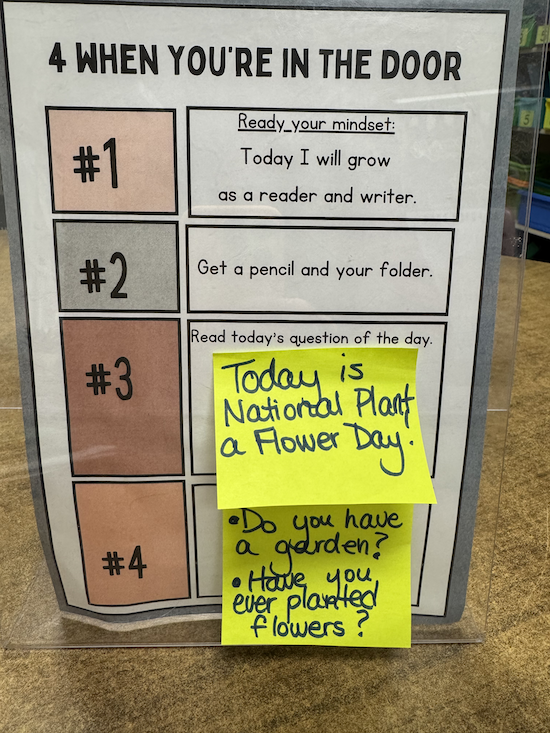
Our mantra is: Today I will grow as a reader and writer. Students silently read the line to internalize it, then say it again with me.
As I tell them, many professional athletes repeat mantras before competing. In “Reciting a Mantra Can Alter Your Brain Chemistry – In a Good Way” health expert Amanda Lucci shows how training the brain is just as important as an athlete’s physical workout. For example, Olympic medalist, Anna Cockrell, echoes a single word, desire, to help find her flow.
Positive self-talk goes a long way in building self-confidence. What affirmation works with your students?
2. MAKING CONNECTIONS
After readying mindsets, class kicks off with conversation about a question of the day. It’s kind of like old-school dinner table talk. Students practice active listening skills with high-interest, low-stakes content. Often, one student piggybacks a response off a classmate’s; some ask clarifying questions.
Yesterday, a question about our favorite foods helped us learn about different cultures. And to leverage as much as possible from this two-minute communication powerhouse, I connect back to students’ answers during the lesson. A win-win!
3. ACCOUNTABILITY
Student-centered classrooms are ideal environments for students to take ownership of their learning. Put students in the driver seat by encouraging them to set goals (another soft skill). Make goals small and achievable, so students feel success quickly. This gives the morale boost they need to seek out grander goals.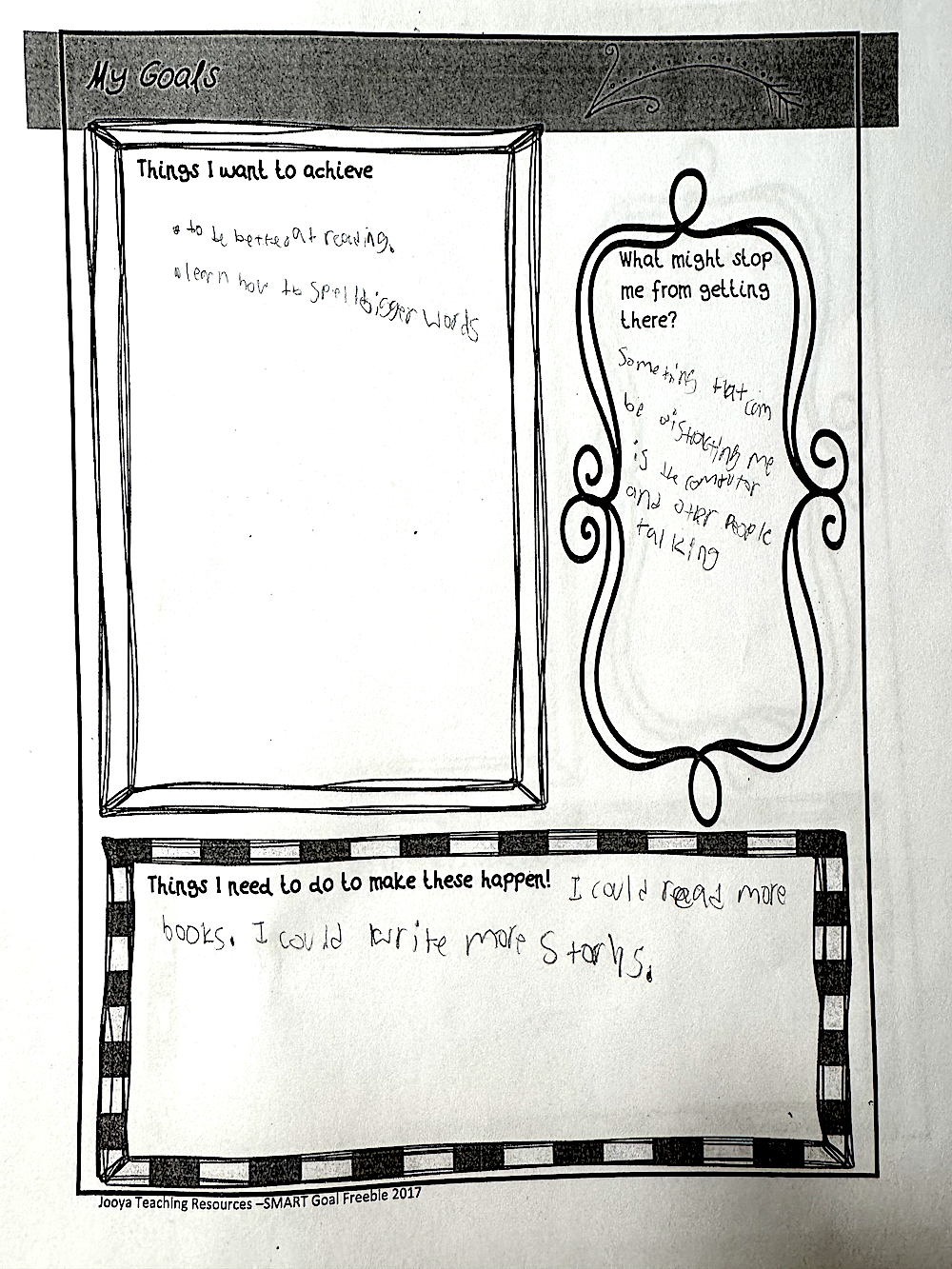 While setting a literacy goal, this student also reflected on distractions that could prevent him from achieving it. When he reassessed progress weeks later, he proudly reported that he stopped listening to distracting music while writing. His literacy scores soared!
While setting a literacy goal, this student also reflected on distractions that could prevent him from achieving it. When he reassessed progress weeks later, he proudly reported that he stopped listening to distracting music while writing. His literacy scores soared!
4. GROW MORE GRIT
Meet students where they are at. Students come to us at all different developmental stages. Don’t expect every student to hit the same mark at the same time. Perseverance is a soft skill. Encourage all students to grow beyond the comfort zone of “good enough.” Then progress to “better” and grow towards achieving personal best.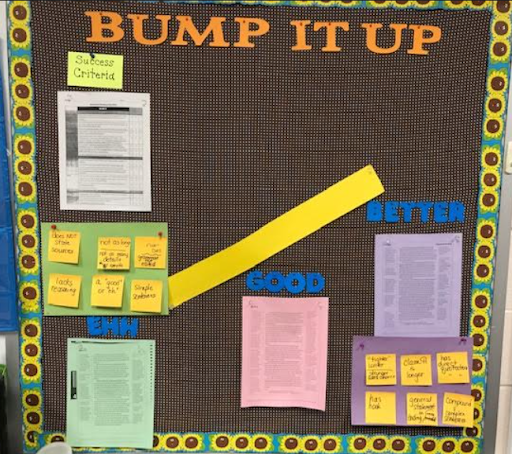
Students develop grit by building stamina to persevere. Remember, a student who hasn’t reached the learning objectives hasn’t failed, they are just not there yet.
5. REDUCE MISUNDERSTANDINGS THROUGH COMMUNICATION
Don’t assume! Just because something seems easy or obvious to us doesn’t mean students know how to do it properly. It’s important we don’t come to premature conclusions. Rather, explain instructions clearly and model. Err on the side of over-explaining.
As explained in my MiddleWeb article “‘Draft Alongs’ Help Kids Grow Olympic Mindsets,” despite all the hours students spend on devices, I needed to model how to indent and space paragraphs. Dialogue is especially tricky to format, so modeling my think-aloud process while projecting an image of my document led to many aha moments about proper formatting.
6. TEACH AND MODEL SELF-MONITORING
Embrace errors! Learning to bounce back from setbacks is key to growing. Instruct students how to minimize errors and cope with imperfection.
One way is to teach routines that check for errors. Visible reminders, such as the checklist below, help students self-reflect and actively look for errors. Most industries follow protocols to reduce errors and have standard operating procedures. Doctors do it before surgery. Pilots run through a checklist before takeoff. Merchants have steps to close the store each day. Let’s get students in the habit now.
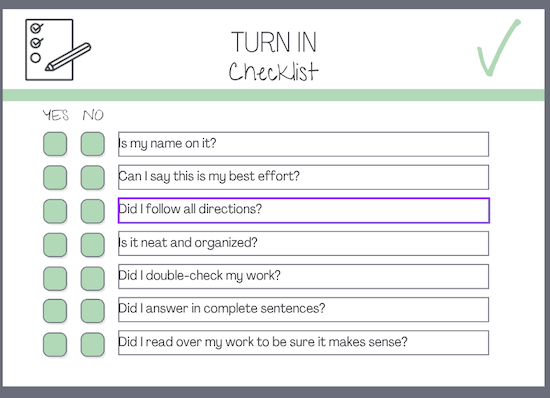
7. TIME MANAGEMENT
Teach how to prioritize tasks, create schedules, and meet deadlines. Use chunking to break large tasks into small manageable steps. Introduce:
- Task batching: List all tasks, categorize them, then group similar tasks.
- Kanban Boards: Visualization tools show a group of tasks and their status.
- Pomodoro Method: Follow 25-minute focused work intervals, broken by 5-minute breaks, and a long break of 15-30 minutes after 4 rounds (pomodori).
8. BOOST THEIR FLEXIBILITY
Agile learners have a mindset and skill set to adapt to changes in the learning environment. Our lessons are full of different formats – teacher-directed, student-driven, project-based, online. Mixing it up has its pros, but can be overwhelming for some students. Eliminate frustration about all the changes. Model how to embrace flexibility.
Try posting visual schedules or teach movement cues, so students know when to expect transitions. Signals such as music, clapping, or silent gestures give students time to mentally prepare for change.
9. MIND THE COGNITIVE LOAD
Have you ever taken a course where the instructor gave you time to write, but then proceeded to talk at the class? I think of that experience whenever students (especially multilingual learners) are writing. The cognitive load is already heavy enough without expecting them to listen to verbal instructions too. There are only so many things a human brain can focus on at once.
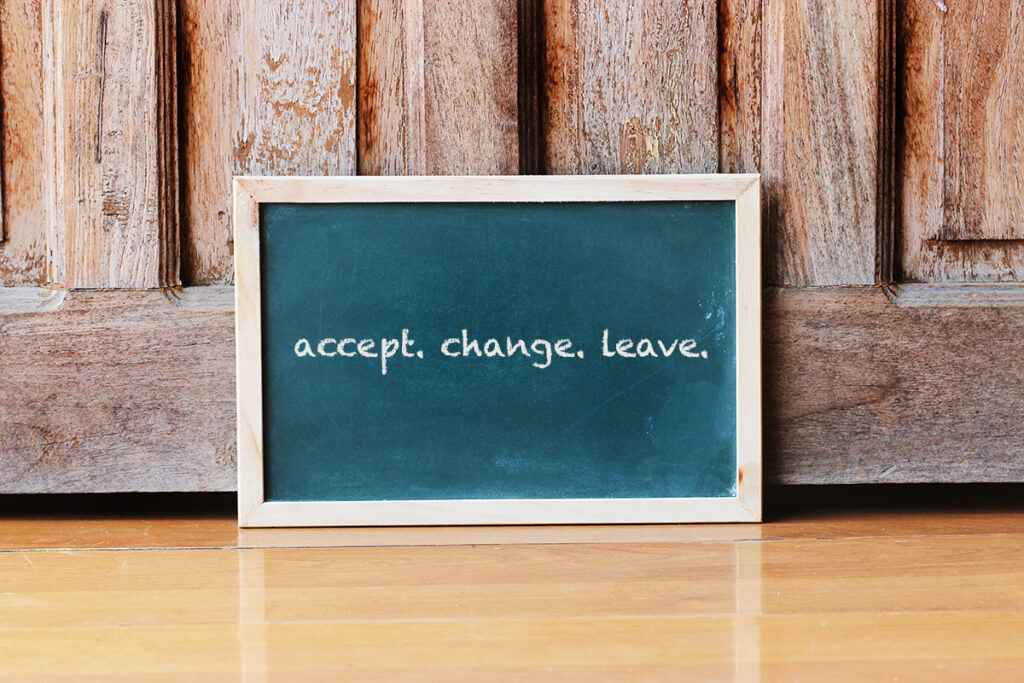
No comments:
Post a Comment